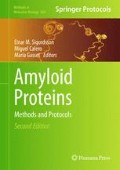Abstract
The increased availability of transgenic mouse models for studying human diseases has shifted the focus of many laboratories from in vitro to in vivo assays. Herein, methods are described to allow investigators to obtain well-preserved mouse tissue to be stained with the standard histological dyes for amyloid, Congo Red, and Thioflavin S. These sections can as well be used for immunohistological procedures that allow detection of tissue amyloid and pre-amyloid, such as those composed of the amyloid-β peptide, the tau protein, and the islet amyloid polypeptide.
Access this chapter
Tax calculation will be finalised at checkout
Purchases are for personal use only
References
Kitamoto, T., Ogomori, K., Tateishi, J., and Prusiner, S. B. (1987) Formic acid pretreatment enhances immunostaining of cerebral and systemic amyloids. Lab Invest 57, 230–236.
Davies, L., Wolska, B., Hilbich, C., Multhaup, G., Martins, R., Simms, G., Beyreuther, K., and Masters, C. L. (1988) A4 amyloid protein deposition and the diagnosis of Alzheimer’s disease: prevalence in aged brains determined by immunocytochemistry compared with conventional neuropathologic techniques. Neurology 38, 1688–1693.
Gentleman, S. M., Bruton, C., Allsop, D., Lewis, S. J., Polak, J. M., and Roberts, G. W. (1989) A demonstration of the advantages of immunostaining in the quantification of amyloid plaque deposits. Histochemistry 92, 355–358.
Lamy, C., Duyckaerts, C., Delaere, P., Payan, C., Fermanian, J., Poulain, V., and Hauw, J. J. (1989) Comparison of seven staining methods for senile plaques and neurofibrillary tangles in a prospective series of 15 elderly patients. Neuropathol. Appl. Neurobiol. 15, 563–578.
Wisniewski, H. M., Wen, G. Y., and Kim, K. S. (1989) Comparison of four staining methods on the detection of neuritic plaques. Acta Neuropathol. (Berl) 78, 22–27.
Vallet, P. G., Guntern, R., Hof, P. R., Golaz, J., Delacourte, A., Robakis, N. K., and Bouras, C. (1992) A comparative study of histological and immunohistochemical methods for neurofibrillary tangles and senile plaques in Alzheimer’s disease. Acta Neuropathol. (Berl) 83, 170–178.
Raskin, L. S., Applegate, M. D., Price, D. L., Troncoso, J. C., and Hedreen, J. C. (1995) Comparison of new and traditional methods for detection of senile plaques in Alzheimer’s disease. J. Geriatr. Psychiatry Neurol. 8, 125–131.
Cullen, K. M., Halliday, G. M., Cartwright, H., and Kril, J. J. (1996) Improved selectivity and sensitivity in the visualization of neurofibrillary tangles, plaques and neuropil threads. Neurodegeneration. 5, 177–187.
Shiurba, R. A., Spooner, E. T., Ishiguro, K., Takahashi, M., Yoshida, R., Wheelock, T. R., Imahori, K., Cataldo, A. M., and Nixon, R. A. (1998) Immunocytochemistry of formalin-fixed human brain tissues: microwave irradiation of free-floating sections. Brain Res. Brain Res. Protoc. 2, 109–119.
Cummings, B. J., Mason, A. J., Kim, R. C., Sheu, P. C., and Anderson, A. J. (2002) Optimization of techniques for the maximal detection and quantification of Alzheimer’s-related neuropathology with digital imaging. Neurobiol. Aging 23, 161–170.
Sigurdsson, E. M., Lorens, S. A., Hejna, M. J., Dong, X. W., and Lee, J. M. (1996) Local and distant histopathological effects of unilateral amyloid-β 25-35 injections into the amygdala of young F344 rats. Neurobiol. Aging 17, 893–901.
Sigurdsson, E. M., Lee, J. M., Dong, X. W., Hejna, M. J., and Lorens, S. A. (1997) Bilateral injections of amyloid-β 25-35 into the amygdala of young Fischer rats: Behavioral, neurochemical, and time dependent histopathological effects. Neurobiol. Aging 18, 591–608.
Sigurdsson, E. M., Scholtzova, H., Mehta, P. D., Frangione, B., and Wisniewski, T. (2001) Immunization with a non-toxic/non-fibrillar amyloid-β homologous peptide reduces Alzheimer’s disease associated pathology in transgenic mice. Am. J. Pathol. 159, 439–447.
Asuni, A. A., Boutajangout, A., Quartermain, D., and Sigurdsson, E. M. (2007) Immunotherapy targeting pathological tau conformers in a tangle mouse model reduces brain pathology with associated functional improvements. J. Neurosci. 27, 9115–9129.
Davies, P. Tau immunohistochemistry protocol: Mice. http://alzforum.org/res/com/protocol/protocol.aspx?pid=3 Accessed 25 March 2011.
Acknowledgments
This work was supported by NIHs grant AG20197, AG032611, and DK075494 and the Alzheimer’s Association. These protocols were in part adapted from methods obtained from Stanley A. Lorens and Debra Magnuson at Loyola University Chicago. We thank Drs. Fernando Goñi and Ayodeji Asuni for their comments on the original manuscript, which has now been substantially updated and expanded in this second edition of the book.
Author information
Authors and Affiliations
Corresponding author
Editor information
Editors and Affiliations
Rights and permissions
Copyright information
© 2012 Springer Science+Business Media, LLC
About this protocol
Cite this protocol
Rajamohamedsait, H.B., Sigurdsson, E.M. (2012). Histological Staining of Amyloid and Pre-amyloid Peptides and Proteins in Mouse Tissue. In: Sigurdsson, E., Calero, M., Gasset, M. (eds) Amyloid Proteins. Methods in Molecular Biology, vol 849. Humana Press. https://doi.org/10.1007/978-1-61779-551-0_28
Download citation
DOI: https://doi.org/10.1007/978-1-61779-551-0_28
Published:
Publisher Name: Humana Press
Print ISBN: 978-1-61779-550-3
Online ISBN: 978-1-61779-551-0
eBook Packages: Springer Protocols

